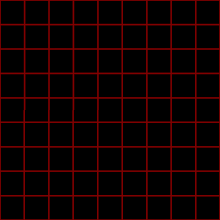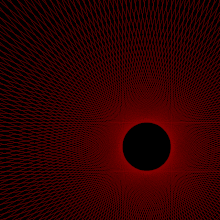Laguerre transformations
The Laguerre transformations or axial homographies are an analogue of Möbius transformations over the dual numbers.[1][2][3][4] When studying these transformations, the dual numbers are often interpreted as representing oriented lines on the plane.[1] The Laguerre transformations map lines to lines, and include in particular all isometries of the plane (ignoring possible orientation reversals).
Strictly speaking, these transformations act on the dual number projective line, which adjoins to the dual numbers a set of points at infinity. Topologically, this projective line is equivalent to a cylinder. Points on this cylinder are in a natural one-to-one correspondence with oriented lines on the plane.
Definition
A Laguerre transformation is a function of the form where are all dual numbers, lies on the dual number projective line, and is not a zero divisor.
A dual number is a hypercomplex number of the form where but . This can be compared to the complex numbers which are of the form where . The dual number projective line adjoins to the dual numbers a set of numbers of the form for any real .
Line coordinates
A line which makes an angle with the x-axis, and whose x-intercept is denoted , is represented by the dual number
The above doesn't make sense when the line is parallel to the x-axis. In that case, if then set where is the y-intercept of the line. This may not appear to be valid, as one is dividing by a zero divisor, but this is a valid point on the projective dual line. If then set .
Finally, observe that these coordinates represent oriented lines. An oriented line is an ordinary line with one of two possible orientations attached to it. This can be seen from the fact that if is increased by then the resulting dual number representative is not the same.
Matrix representations
It's possible to express the above line coordinates as homogeneous coordinates where is the perpendicular distance of the line from the origin. This representation has numerous advantages: One advantage is that there is no need to break into different cases, such as parallel and non-parallel. The other advantage is that these homogeneous coordinates can be interpreted as vectors, allowing us to multiply them by a matrix.
Every Laguerre transformation can be represented as a 2x2 matrix whose entries are dual numbers. Additionally, as long as the determinant of a 2x2 dual-numbered matrix is not nilpotent, then it represents a Laguerre transformation.
Points, oriented lines and oriented circles
Laguerre transformations do not act on points. This is because if three oriented lines pass through the same point, their images under a Laguerre transformation do not have to meet at one point.
Laguerre transformations can be seen as acting on oriented circles as well as oriented lines. An oriented circle is one which either has a clockwise or anti-clockwise orientation. An anti-clockwise orientation is considered to be positive, while a clockwise orientation is considered to be negative. The radius of a negatively oriented circle is negative. Whenever a set of oriented lines are tangent to the same oriented circle, their images under a Laguerre transformation share this property, but possibly for a different circle. An oriented line is tangent to an oriented circle if the two figures touch and their orientations agree.
Profile

The following can be found in Isaak Yaglom's Complex numbers in geometry.[1]
Mappings of the form express rigid body motions. The matrix representations of these transformations span a subalgebra isomorphic to the dual-complex numbers.
The mapping represents a reflection about the x-axis, followed by a reversal of orientation.
The transformation expresses a reflection about the y-axis, followed by a reversal of orientation.
An axial dilatation by units is a transformation of the form . A dilatation by units increases the radius of all oriented circles by units while preserving their centres. If a circle has negative orientation, then its radius is considered negative, and therefore for some positive values of the circle actually shrinks. A progressive dilatation is depicted in Figure 1, in which two circles of opposite orientations undergo the same dilatation.
On lines, an axial dilatation by units maps any line to a line such that and are parallel, and the perpendicular distance between and is . Lines that are parallel but have opposite orientations move in opposite directions.


The transformation for a value of that's real preserves the x-intercept of a line, while changing its angle to the x-axis. See Figure 2 to observe the effect on a grid of lines (including the x axis in the middle) and Figure 3 to observe the effect on two circles that differ initially only in orientation (to see that the outcome is sensitive to orientation).
All Laguerre transformations are either:
- Direct Euclidean isometries followed by an axial dilatation.
- Indirect Euclidean isometries, followed by an axial dilatation, followed by orientation reversal.
- Indirect Euclidean isometries, followed by a transformation of the form for a real number, followed by orientation reversal.
See also
References
- "Complex Numbers in Geometry | ScienceDirect". www.sciencedirect.com. Retrieved 2020-06-12.
- Bolt, Michael; Ferdinands, Timothy; Kavlie, Landon (2009). "The most general planar transformations that map parabolas into parabolas". Involve: A Journal of Mathematics. 2 (1): 79–88. doi:10.2140/involve.2009.2.79. ISSN 1944-4176.
- Fillmore, Jay P.; Springer, Arthur (1995-03-01). "New euclidean theorems by the use of Laguerre transformations — Some geometry of Minkowski (2+1)-space". Journal of Geometry. 52 (1): 74–90. doi:10.1007/BF01406828. ISSN 1420-8997.
- Barrett, David E.; Bolt, Michael (June 2010). "Laguerre Arc Length from Distance Functions". Asian Journal of Mathematics. 14 (2): 213–234. ISSN 1093-6106.